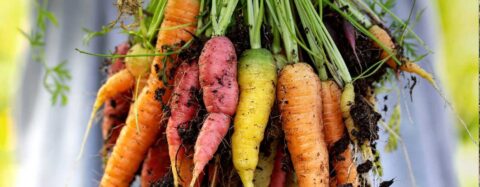Mānuka is prized for its healing honey and nurturing role in forest regeneration, but Lynda Hallinan knows all about the surly side of this colourful native.
For a native plant whose healing properties are legendary, I’m afraid to say that mānuka brings me more grief than goodwill – and not just because its needle-like leaves have sharp, jabbing tips.
Mānuka (Leptospermum scoparium) is a horticultural conundrum, a hardy soul that likes living rough in the bush, but behaves like a prima donna when pampered in my garden. In the wild, it colonises landscapes scarred by fire, slips and roading earthworks, taking the first regenerative baby steps back to native forest. But in my backyard? It sulks in the shade of taller companions, is shy about flowering, turns up its toes if I deign to plant it in fertile soil, or falls victim to scale insects and a black plague of sooty mould fungus.
And yet, as the English poet Elizabeth Barrett Browning would say, had she penned gardening advice instead of romantic sonnets, “How do I love thee, mānuka? Let me count the ways.”
I love thee to the depth of a spade (mānuka is fairly shallow-rooted) and the breadth of a shrub (allow a metre or two). I love thee for billy tea and bringing in bees and lashing together tepees to support sweet peas. And, less poetically, for infusing sides of kahawai – the only fish my husband ever seems to catch these days – with wood-smokey deliciousness.
Fiery spread
The popularity of mānuka has come full circle since the early days of European settlement in New Zealand, when farmers burned bush to clear land to sow grass. (This had the opposite effect, for mānuka is thought to be more Aussie than Kiwi in origin and, like many Australian natives, its spread is actually accelerated by fire, the heat causing its woody seed capsules to split, explode and eject plumes of fine seeds into the wind.)
In the bush, mānuka is often confused with its cousin kānuka (Kunzea ericoides), but my niece’s boyfriend recently taught me a nifty way to tell them apart. “Mānuka is mean, kānuka is kind,” he said, for mānuka has spiky foliage, but kānuka is soft to touch.
Both were once considered a vexatious pasture pest, but mānuka is now a prized crop for flower farmers and beekeepers. Its nectar contains natural antiviral, anti-inflammatory and antioxidant compounds that give mānuka honey its famous health-giving properties – and a hefty price tag.
I start every day with a spoonful of mānuka honey in my morning coffee. I’ve been told that eating locally sourced honey helps to calm hay fever symptoms by building up a natural immunity to the aggravations of pollen allergies, but even if it doesn’t, it certainly sweetens my mood for the school run.
A member of the myrtle family, Leptospermum scoparium is unique to Australia and New Zealand and, like pavlova and Phar Lap, we both patriotically claim its provenance. However, botanists concede that mānuka is likely a fairly recent immigrant to our shores, and was probably blown across the ditch only a few million years ago.
The original species is a medium-sized shrub with single white five-petalled flowers, but there’s significant natural variation in size, flower colour and form. In the wild, there are ground-hugging shorties and reasonably tall trees, with a floral colour spectrum that ranges from palest pink to crimson-red.
New hybrids developed by crossing our native species with its big sister from New South Wales, the Australian round-leaved tea tree, Leptospermum rotundifolium, are said not to be as susceptible to sooty mould. They’re great garden performers, flowering from late winter.
A few years ago, I bought the large-flowered hybrid ‘Mesmer Eyes’ (geddit?), which has large petals of palest pink around an anemone centre of hot pink eyelashes. Having bought it in full bloom, I figured it deserved a prominent planting spot so I dug it in at the edge of our deck, where it grew leggy and lanky and refused to flower again for five full years. Having finally decided to grace me with its glory, no sooner had it finished than my husband mistook it for a weed and ripped it out.
Mānuka seems to do best in impoverished soils, and in my experience it prefers wet feet to dry, though it’s hardy and drought-tolerant once established. Two years ago I segregated a dozen hybrids in their own heavily mulched bed and now it’s a pleasure – and a pain – to snip sprigs for winter posies and tiny buttonhole sprays.
Just watch your fingers.

Modern mānuka varieties
- In the bush, mānuka has a tendency to be short-lived and scruffy, so the Auckland Botanic Gardens set out to breed neat and tidy plants better suited to garden settings. ‘Wiri Joan’ and ‘Wiri Kerry’ both sport double flowers of bright red, but Joan does her thing in winter, whereas Kerry is a spring pleasure. ‘Wiri Linda’ has frilly white flowers and ‘Wiri Shelley’ has single pink flowers with dark red eyes.
- My favourite frilly double-flowered forms are ‘Princess Anne’ (white with a maroon eye), lipstick pink ‘Rosy Morn’, baby pink ‘Blossom’ and deep red ‘Burgundy Queen’.
- Australian-raised hybrids have finer, almost kānuka-like foliage that is fully smothered in flower. ‘Outrageous’ is a stunner with large, tomato-red flowers, while ‘Tickled Pink’ is the clear pink of showground candyfloss. For purple tones, there’s ‘Pageant’ and deep mauve ‘Phoenix’.
- In botanical Latin, nanum means dwarf, and there’s a good selection of compact varieties bred from a naturally dwarf plant that was found keeping its head down low on the Central Plateau in 1940. Named after New Zealand native birds, there’s ‘Nanum Kea’ (pink and white), ‘Nanum Kiwi’(pale red), ‘Nanum Tūī’ (white flushed with pink), ‘Nanum Huia’ (reddish-pink) and ‘Nanum Ruru’ (red). All are lovely petite plants for pots and patio gardens, though not much chop as cut flowers.








